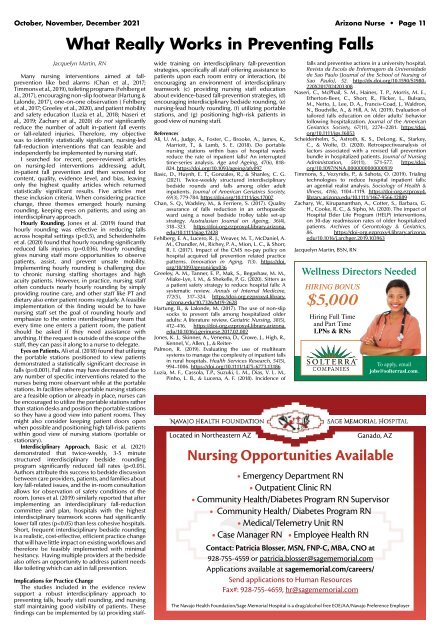Arizona Nurse - October 2021
Create successful ePaper yourself
Turn your PDF publications into a flip-book with our unique Google optimized e-Paper software.
<strong>October</strong>, November, December <strong>2021</strong> <strong>Arizona</strong> <strong>Nurse</strong> • Page 11<br />
What Really Works in Preventing Falls<br />
Jacquelyn Martin, RN<br />
Many nursing interventions aimed at fallprevention<br />
like bed alarms (Chan et al., 2017;<br />
Timmons et al., 2019), toileting programs (Fehlberg et<br />
al., 2017), encouraging non-slip footwear (Hartung &<br />
Lalonde, 2017), one-on-one observation ( Fehlberg<br />
et al., 2017; Greeley et al., 2020), and patient mobility<br />
and safety education (Luzia et al., 2018; Naseri et<br />
al., 2019; Zachary et al., 2020) do not significantly<br />
reduce the number of adult in-patient fall events<br />
or fall-related injuries. Therefore, my objective<br />
was to identify statistically significant, nursing-led<br />
fall-reduction interventions that can feasible and<br />
independently be implemented by nursing staff.<br />
I searched for recent, peer-reviewed articles<br />
on nursing-led interventions addressing adult,<br />
in-patient fall prevention and then screened for<br />
content, quality, evidence level, and bias, leaving<br />
only the highest quality articles which returned<br />
statistically significant results. Five articles met<br />
these inclusion criteria. When considering practice<br />
change, three themes emerged: hourly nursing<br />
rounding, keeping eyes on patients, and using an<br />
interdisciplinary approach.<br />
Hourly Rounding. Jones et al. (2019) found that<br />
hourly rounding was effective in reducing falls<br />
across hospital settings (p

















